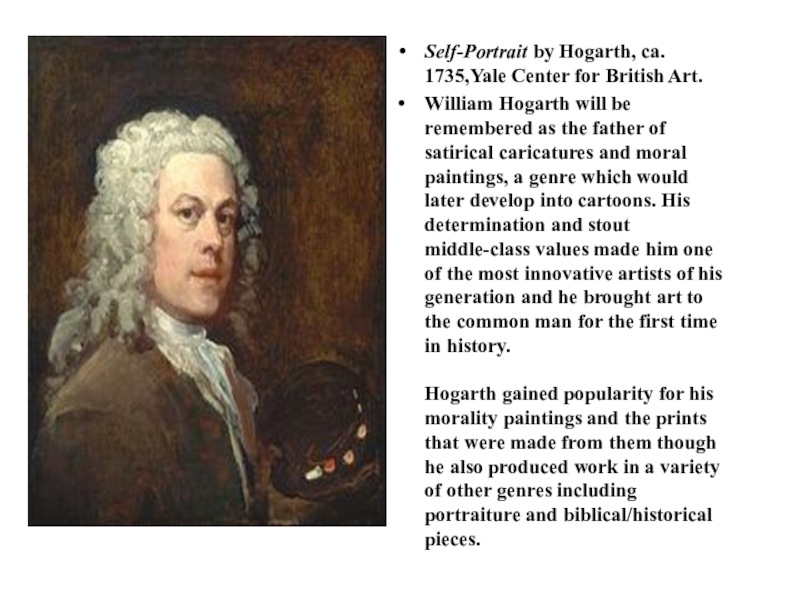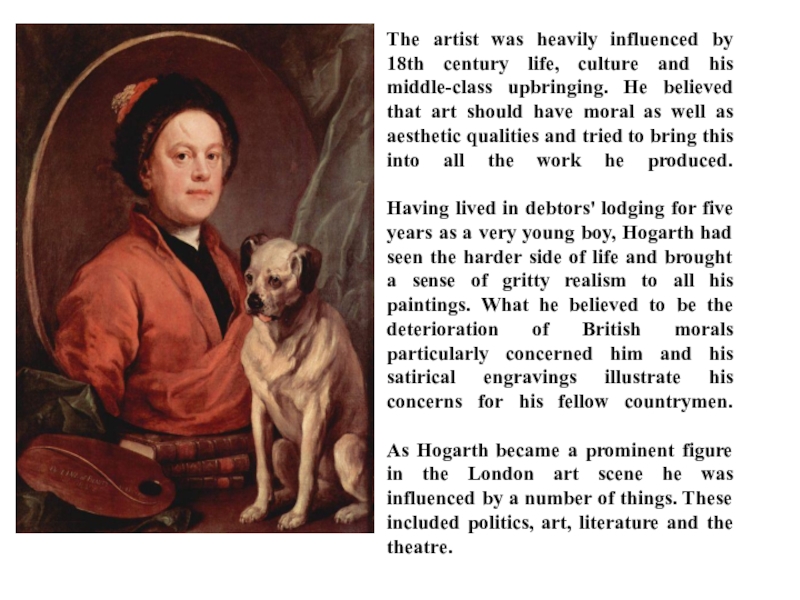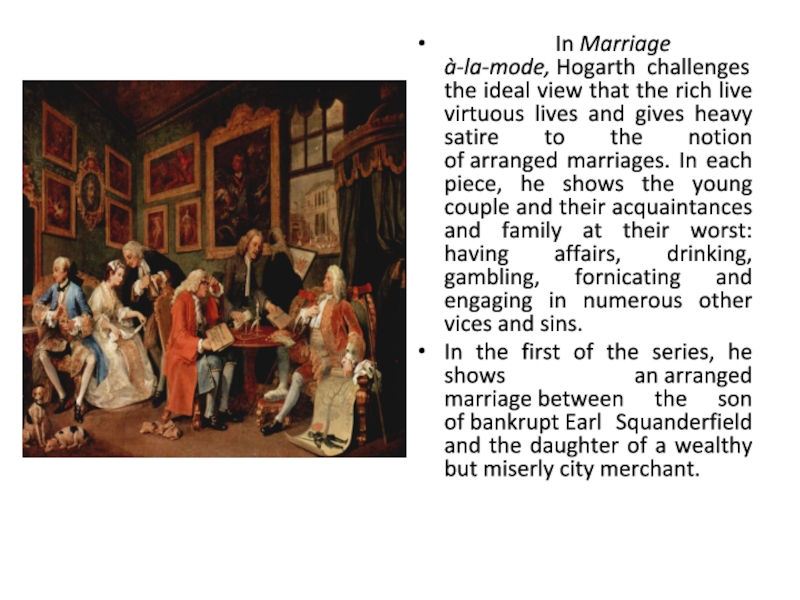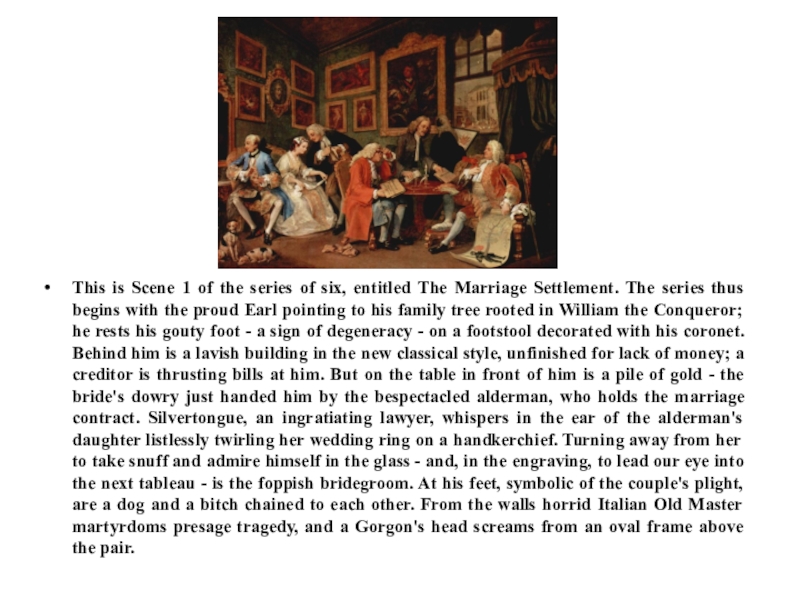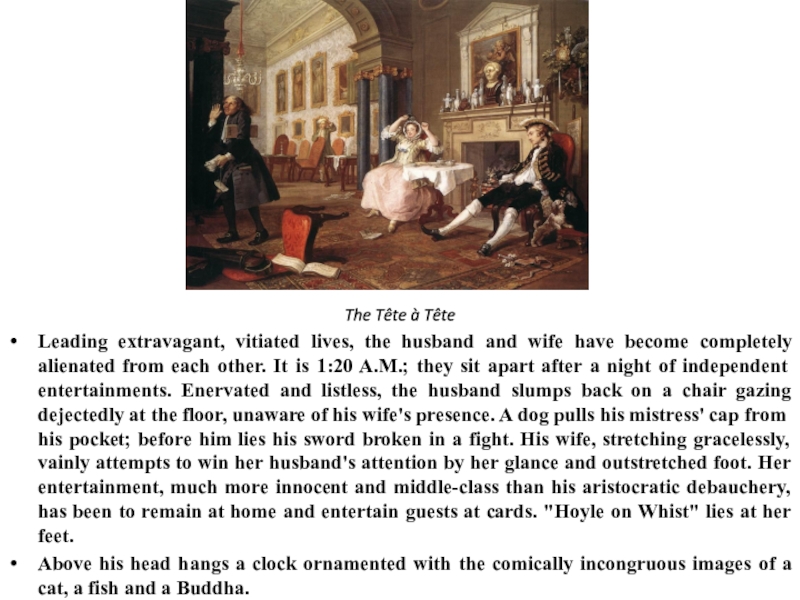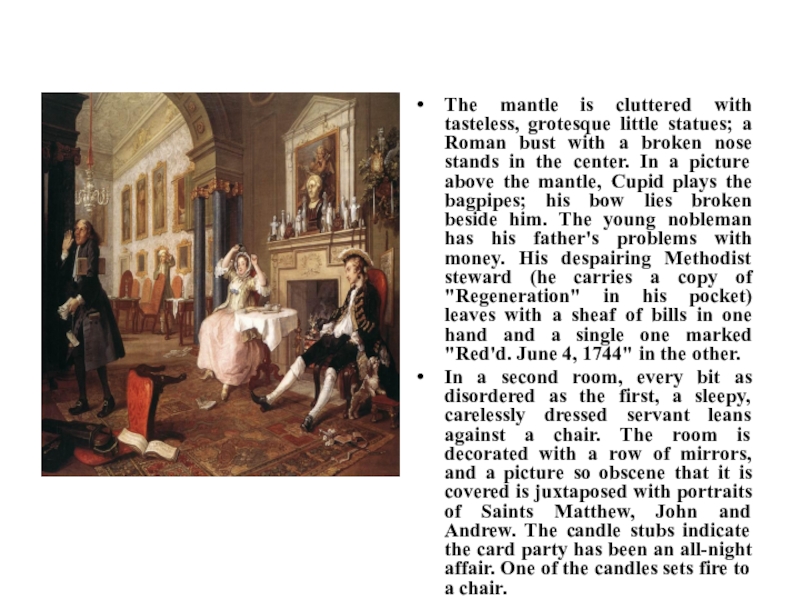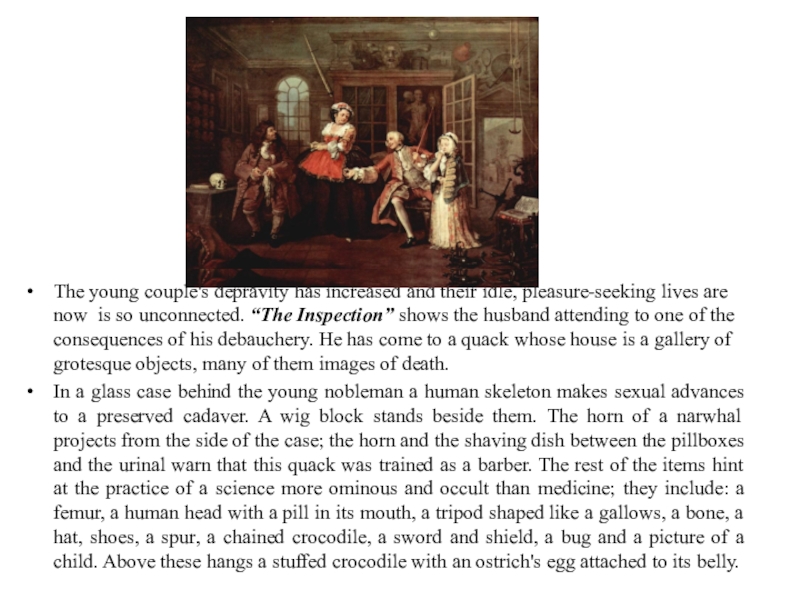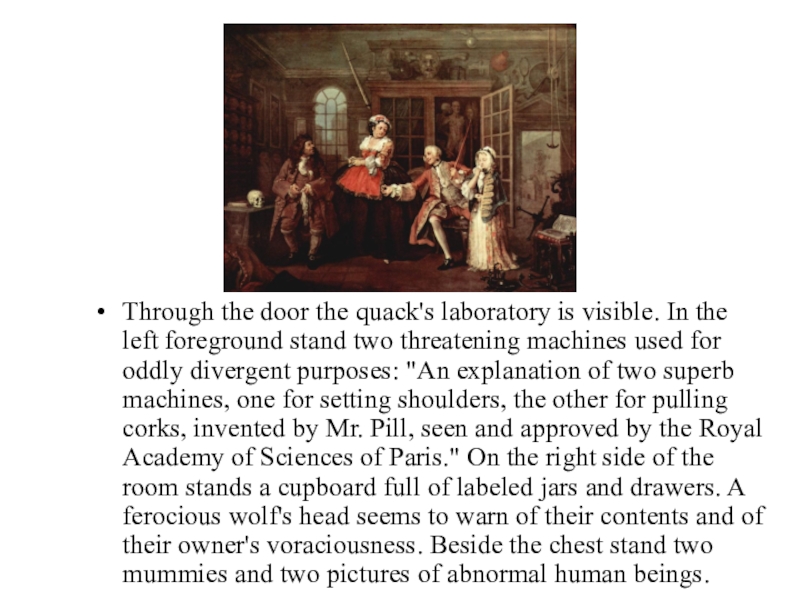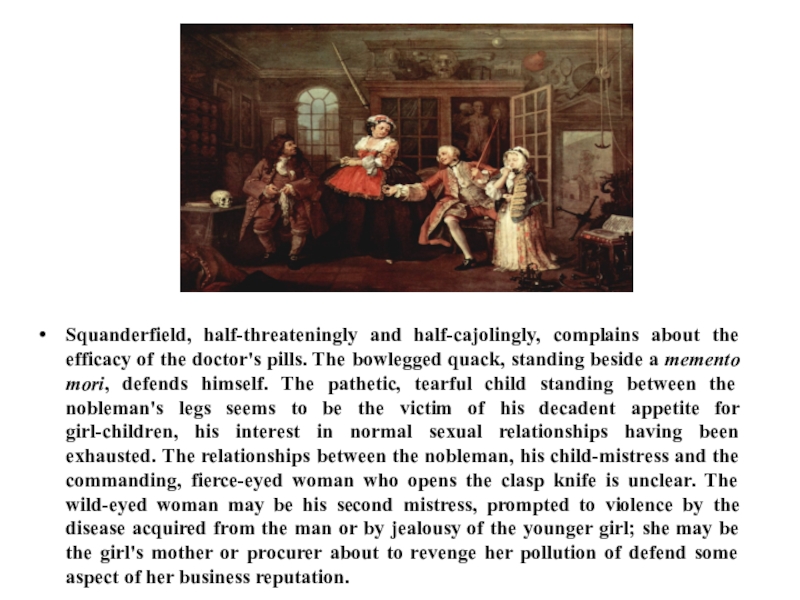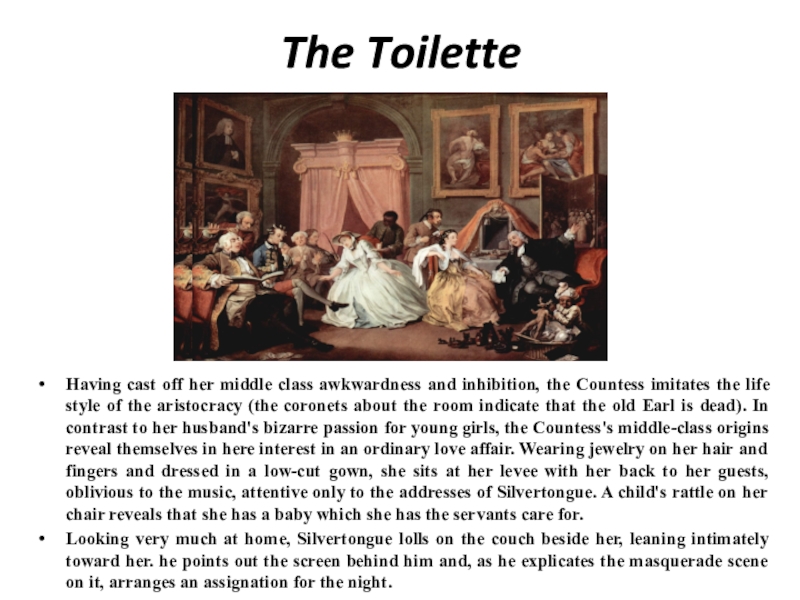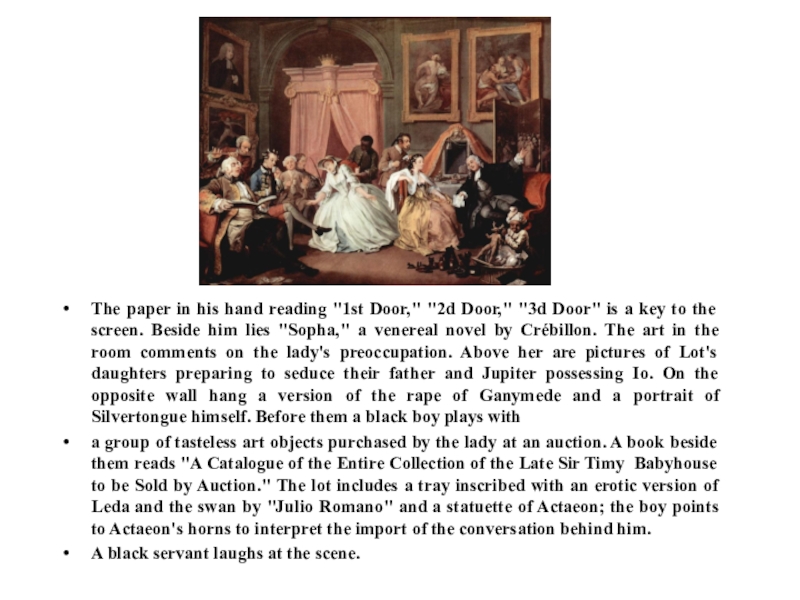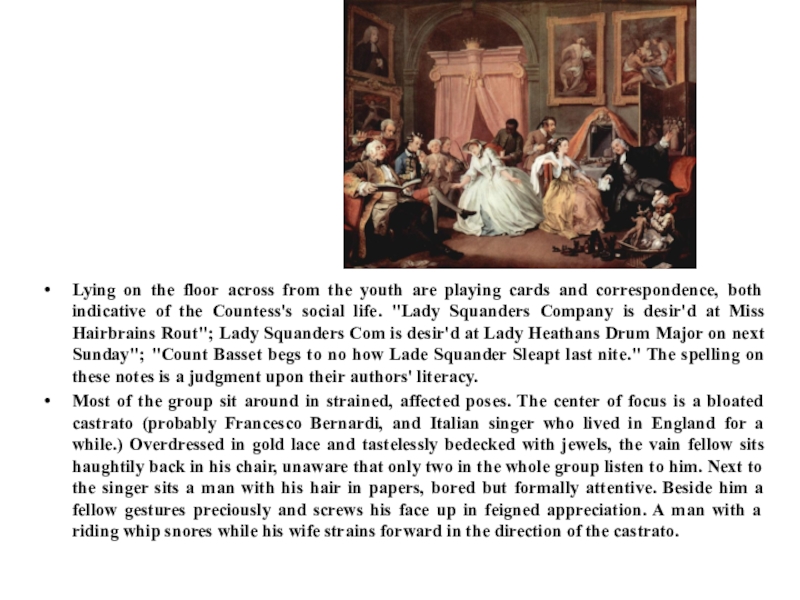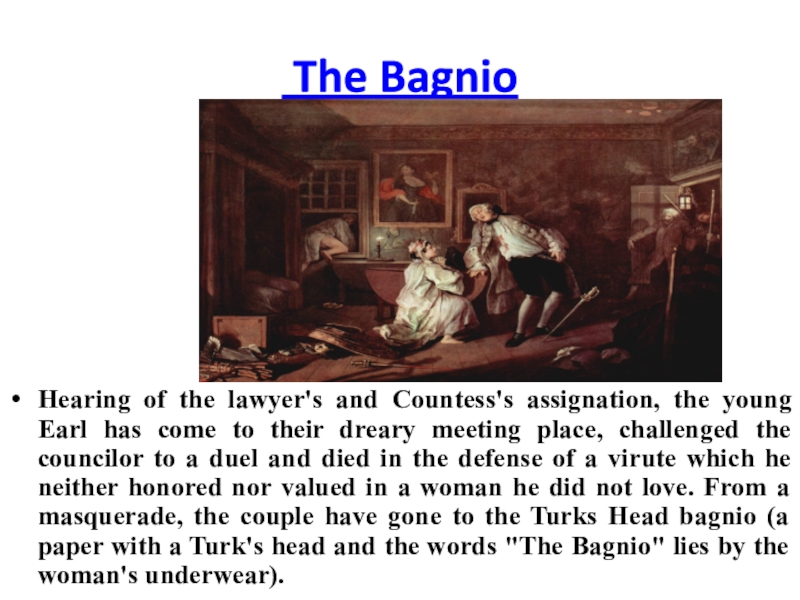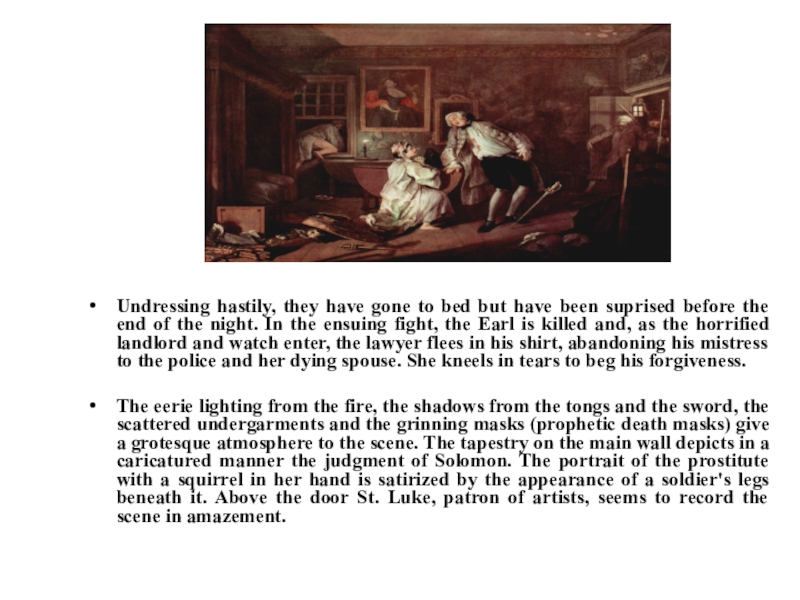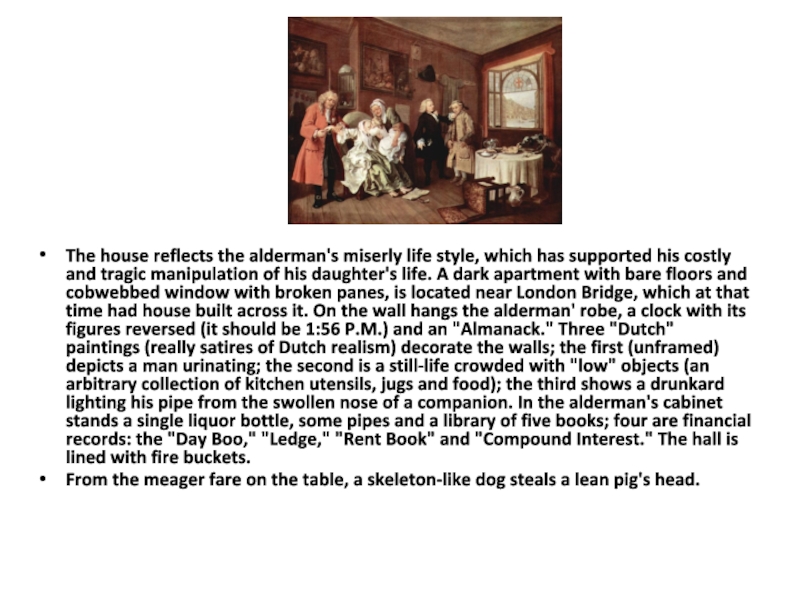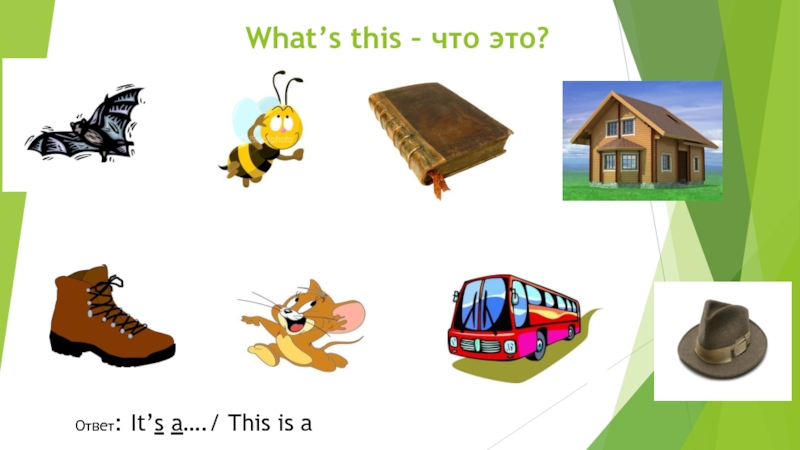- Главная
- Разное
- Образование
- Спорт
- Естествознание
- Природоведение
- Религиоведение
- Французский язык
- Черчение
- Английский язык
- Астрономия
- Алгебра
- Биология
- География
- Геометрия
- Детские презентации
- Информатика
- История
- Литература
- Математика
- Музыка
- МХК
- Немецкий язык
- ОБЖ
- Обществознание
- Окружающий мир
- Педагогика
- Русский язык
- Технология
- Физика
- Философия
- Химия
- Шаблоны, фоны, картинки для презентаций
- Экология
- Экономика
Презентация, доклад по английскому языку по теме English Painting. William Hoggart (10 - 11 класс)
Содержание
- 1. Презентация по английскому языку по теме English Painting. William Hoggart (10 - 11 класс)
- 2. Self-Portrait by Hogarth, ca. 1735,Yale Center for British
- 3. The artist was heavily influenced by 18th
- 4. In Marriage à-la-mode, Hogarth challenges the ideal view
- 5. This is Scene 1 of the series
- 6. The Tête à TêteLeading extravagant, vitiated lives,
- 7. The mantle is cluttered with tasteless, grotesque
- 8. The young couple's depravity has increased and
- 9. Through the door the quack's laboratory is
- 10. Squanderfield, half-threateningly and half-cajolingly, complains about the
- 11. The ToiletteHaving cast off her middle class awkwardness
- 12. The paper in his hand reading "1st
- 13. Lying on the floor across from the
- 14. The BagnioHearing of the lawyer's and Countess's
- 15. Undressing hastily, they have gone to bed
- 16. The Lady's DeathHer husband killed and her
- 17. The house reflects the alderman's miserly life
Self-Portrait by Hogarth, ca. 1735,Yale Center for British Art.William Hogarth will be remembered as the father of satirical caricatures and moral paintings, a genre which would later develop into cartoons. His determination and stout middle-class values made
Слайд 2Self-Portrait by Hogarth, ca. 1735,Yale Center for British Art.
William Hogarth will be
remembered as the father of satirical caricatures and moral paintings, a genre which would later develop into cartoons. His determination and stout middle-class values made him one of the most innovative artists of his generation and he brought art to the common man for the first time in history.
Hogarth gained popularity for his morality paintings and the prints that were made from them though he also produced work in a variety of other genres including portraiture and biblical/historical pieces.
Слайд 3The artist was heavily influenced by 18th century life, culture and
his middle-class upbringing. He believed that art should have moral as well as aesthetic qualities and tried to bring this into all the work he produced.
Having lived in debtors' lodging for five years as a very young boy, Hogarth had seen the harder side of life and brought a sense of gritty realism to all his paintings. What he believed to be the deterioration of British morals particularly concerned him and his satirical engravings illustrate his concerns for his fellow countrymen.
As Hogarth became a prominent figure in the London art scene he was influenced by a number of things. These included politics, art, literature and the theatre.
Слайд 4 In Marriage à-la-mode, Hogarth challenges the ideal view that the rich live
virtuous lives and gives heavy satire to the notion of arranged marriages. In each piece, he shows the young couple and their acquaintances and family at their worst: having affairs, drinking, gambling, fornicating and engaging in numerous other vices and sins.
In the first of the series, he shows an arranged marriage between the son of bankrupt Earl Squanderfield and the daughter of a wealthy but miserly city merchant.
In the first of the series, he shows an arranged marriage between the son of bankrupt Earl Squanderfield and the daughter of a wealthy but miserly city merchant.
Слайд 5This is Scene 1 of the series of six, entitled The
Marriage Settlement. The series thus begins with the proud Earl pointing to his family tree rooted in William the Conqueror; he rests his gouty foot - a sign of degeneracy - on a footstool decorated with his coronet. Behind him is a lavish building in the new classical style, unfinished for lack of money; a creditor is thrusting bills at him. But on the table in front of him is a pile of gold - the bride's dowry just handed him by the bespectacled alderman, who holds the marriage contract. Silvertongue, an ingratiating lawyer, whispers in the ear of the alderman's daughter listlessly twirling her wedding ring on a handkerchief. Turning away from her to take snuff and admire himself in the glass - and, in the engraving, to lead our eye into the next tableau - is the foppish bridegroom. At his feet, symbolic of the couple's plight, are a dog and a bitch chained to each other. From the walls horrid Italian Old Master martyrdoms presage tragedy, and a Gorgon's head screams from an oval frame above the pair.
Слайд 6The Tête à Tête
Leading extravagant, vitiated lives, the husband and wife
have become completely alienated from each other. It is 1:20 A.M.; they sit apart after a night of independent entertainments. Enervated and listless, the husband slumps back on a chair gazing dejectedly at the floor, unaware of his wife's presence. A dog pulls his mistress' cap from his pocket; before him lies his sword broken in a fight. His wife, stretching gracelessly, vainly attempts to win her husband's attention by her glance and outstretched foot. Her entertainment, much more innocent and middle-class than his aristocratic debauchery, has been to remain at home and entertain guests at cards. "Hoyle on Whist" lies at her feet.
Above his head hangs a clock ornamented with the comically incongruous images of a cat, a fish and a Buddha.
Above his head hangs a clock ornamented with the comically incongruous images of a cat, a fish and a Buddha.
Слайд 7The mantle is cluttered with tasteless, grotesque little statues; a Roman
bust with a broken nose stands in the center. In a picture above the mantle, Cupid plays the bagpipes; his bow lies broken beside him. The young nobleman has his father's problems with money. His despairing Methodist steward (he carries a copy of "Regeneration" in his pocket) leaves with a sheaf of bills in one hand and a single one marked "Red'd. June 4, 1744" in the other.
In a second room, every bit as disordered as the first, a sleepy, carelessly dressed servant leans against a chair. The room is decorated with a row of mirrors, and a picture so obscene that it is covered is juxtaposed with portraits of Saints Matthew, John and Andrew. The candle stubs indicate the card party has been an all-night affair. One of the candles sets fire to a chair.
In a second room, every bit as disordered as the first, a sleepy, carelessly dressed servant leans against a chair. The room is decorated with a row of mirrors, and a picture so obscene that it is covered is juxtaposed with portraits of Saints Matthew, John and Andrew. The candle stubs indicate the card party has been an all-night affair. One of the candles sets fire to a chair.
Слайд 8The young couple's depravity has increased and their idle, pleasure-seeking lives
are now is so unconnected. “The Inspection” shows the husband attending to one of the consequences of his debauchery. He has come to a quack whose house is a gallery of grotesque objects, many of them images of death.
In a glass case behind the young nobleman a human skeleton makes sexual advances to a preserved cadaver. A wig block stands beside them. The horn of a narwhal projects from the side of the case; the horn and the shaving dish between the pillboxes and the urinal warn that this quack was trained as a barber. The rest of the items hint at the practice of a science more ominous and occult than medicine; they include: a femur, a human head with a pill in its mouth, a tripod shaped like a gallows, a bone, a hat, shoes, a spur, a chained crocodile, a sword and shield, a bug and a picture of a child. Above these hangs a stuffed crocodile with an ostrich's egg attached to its belly.
In a glass case behind the young nobleman a human skeleton makes sexual advances to a preserved cadaver. A wig block stands beside them. The horn of a narwhal projects from the side of the case; the horn and the shaving dish between the pillboxes and the urinal warn that this quack was trained as a barber. The rest of the items hint at the practice of a science more ominous and occult than medicine; they include: a femur, a human head with a pill in its mouth, a tripod shaped like a gallows, a bone, a hat, shoes, a spur, a chained crocodile, a sword and shield, a bug and a picture of a child. Above these hangs a stuffed crocodile with an ostrich's egg attached to its belly.
Слайд 9Through the door the quack's laboratory is visible. In the left
foreground stand two threatening machines used for oddly divergent purposes: "An explanation of two superb machines, one for setting shoulders, the other for pulling corks, invented by Mr. Pill, seen and approved by the Royal Academy of Sciences of Paris." On the right side of the room stands a cupboard full of labeled jars and drawers. A ferocious wolf's head seems to warn of their contents and of their owner's voraciousness. Beside the chest stand two mummies and two pictures of abnormal human beings.
Слайд 10Squanderfield, half-threateningly and half-cajolingly, complains about the efficacy of the doctor's
pills. The bowlegged quack, standing beside a memento mori, defends himself. The pathetic, tearful child standing between the nobleman's legs seems to be the victim of his decadent appetite for girl-children, his interest in normal sexual relationships having been exhausted. The relationships between the nobleman, his child-mistress and the commanding, fierce-eyed woman who opens the clasp knife is unclear. The wild-eyed woman may be his second mistress, prompted to violence by the disease acquired from the man or by jealousy of the younger girl; she may be the girl's mother or procurer about to revenge her pollution of defend some aspect of her business reputation.
Слайд 11The Toilette
Having cast off her middle class awkwardness and inhibition, the Countess
imitates the life style of the aristocracy (the coronets about the room indicate that the old Earl is dead). In contrast to her husband's bizarre passion for young girls, the Countess's middle-class origins reveal themselves in here interest in an ordinary love affair. Wearing jewelry on her hair and fingers and dressed in a low-cut gown, she sits at her levee with her back to her guests, oblivious to the music, attentive only to the addresses of Silvertongue. A child's rattle on her chair reveals that she has a baby which she has the servants care for.
Looking very much at home, Silvertongue lolls on the couch beside her, leaning intimately toward her. he points out the screen behind him and, as he explicates the masquerade scene on it, arranges an assignation for the night.
Looking very much at home, Silvertongue lolls on the couch beside her, leaning intimately toward her. he points out the screen behind him and, as he explicates the masquerade scene on it, arranges an assignation for the night.
Слайд 12The paper in his hand reading "1st Door," "2d Door," "3d
Door" is a key to the screen. Beside him lies "Sopha," a venereal novel by Crébillon. The art in the room comments on the lady's preoccupation. Above her are pictures of Lot's daughters preparing to seduce their father and Jupiter possessing Io. On the opposite wall hang a version of the rape of Ganymede and a portrait of Silvertongue himself. Before them a black boy plays with
a group of tasteless art objects purchased by the lady at an auction. A book beside them reads "A Catalogue of the Entire Collection of the Late Sir Timy Babyhouse to be Sold by Auction." The lot includes a tray inscribed with an erotic version of Leda and the swan by "Julio Romano" and a statuette of Actaeon; the boy points to Actaeon's horns to interpret the import of the conversation behind him.
A black servant laughs at the scene.
a group of tasteless art objects purchased by the lady at an auction. A book beside them reads "A Catalogue of the Entire Collection of the Late Sir Timy Babyhouse to be Sold by Auction." The lot includes a tray inscribed with an erotic version of Leda and the swan by "Julio Romano" and a statuette of Actaeon; the boy points to Actaeon's horns to interpret the import of the conversation behind him.
A black servant laughs at the scene.
Слайд 13Lying on the floor across from the youth are playing cards
and correspondence, both indicative of the Countess's social life. "Lady Squanders Company is desir'd at Miss Hairbrains Rout"; Lady Squanders Com is desir'd at Lady Heathans Drum Major on next Sunday"; "Count Basset begs to no how Lade Squander Sleapt last nite." The spelling on these notes is a judgment upon their authors' literacy.
Most of the group sit around in strained, affected poses. The center of focus is a bloated castrato (probably Francesco Bernardi, and Italian singer who lived in England for a while.) Overdressed in gold lace and tastelessly bedecked with jewels, the vain fellow sits haughtily back in his chair, unaware that only two in the whole group listen to him. Next to the singer sits a man with his hair in papers, bored but formally attentive. Beside him a fellow gestures preciously and screws his face up in feigned appreciation. A man with a riding whip snores while his wife strains forward in the direction of the castrato.
Most of the group sit around in strained, affected poses. The center of focus is a bloated castrato (probably Francesco Bernardi, and Italian singer who lived in England for a while.) Overdressed in gold lace and tastelessly bedecked with jewels, the vain fellow sits haughtily back in his chair, unaware that only two in the whole group listen to him. Next to the singer sits a man with his hair in papers, bored but formally attentive. Beside him a fellow gestures preciously and screws his face up in feigned appreciation. A man with a riding whip snores while his wife strains forward in the direction of the castrato.
Слайд 14 The Bagnio
Hearing of the lawyer's and Countess's assignation, the young Earl
has come to their dreary meeting place, challenged the councilor to a duel and died in the defense of a virute which he neither honored nor valued in a woman he did not love. From a masquerade, the couple have gone to the Turks Head bagnio (a paper with a Turk's head and the words "The Bagnio" lies by the woman's underwear).
Слайд 15Undressing hastily, they have gone to bed but have been suprised
before the end of the night. In the ensuing fight, the Earl is killed and, as the horrified landlord and watch enter, the lawyer flees in his shirt, abandoning his mistress to the police and her dying spouse. She kneels in tears to beg his forgiveness.
The eerie lighting from the fire, the shadows from the tongs and the sword, the scattered undergarments and the grinning masks (prophetic death masks) give a grotesque atmosphere to the scene. The tapestry on the main wall depicts in a caricatured manner the judgment of Solomon. The portrait of the prostitute with a squirrel in her hand is satirized by the appearance of a soldier's legs beneath it. Above the door St. Luke, patron of artists, seems to record the scene in amazement.
The eerie lighting from the fire, the shadows from the tongs and the sword, the scattered undergarments and the grinning masks (prophetic death masks) give a grotesque atmosphere to the scene. The tapestry on the main wall depicts in a caricatured manner the judgment of Solomon. The portrait of the prostitute with a squirrel in her hand is satirized by the appearance of a soldier's legs beneath it. Above the door St. Luke, patron of artists, seems to record the scene in amazement.
Слайд 16The Lady's Death
Her husband killed and her lover hanged, the Countess,
returned to her father's house, is driven to suicide by the tragic consequences of the foolish and ill-fated venture perpetrated on her.
Plainly dressed, she expires on a chair as an ineffectual physician scurries away. On the floor lies a bottle of "Laudanum"; next to it the precipitating cause of her suicide, "Counseller Silvertongue last Dying Speech." As her impassive, mercenary father dispassionately removes the ring from her finger, a withered old nurse holds her daughter for a dying kiss. The crippled girl has inherited both her father's veneral disease and his beauty spot; since the young Earl has no male child, his family line has ended. The apothecary, who has a stomach pump and a "julep" bottle in his pocket, points to the empty laudenum bottle, and berates the servant who looks at it uncomprehendingly. The fellow, who wears his master's ill-fitting coat buttoned askew, is an idiot hired cheaply by the alderman.
Plainly dressed, she expires on a chair as an ineffectual physician scurries away. On the floor lies a bottle of "Laudanum"; next to it the precipitating cause of her suicide, "Counseller Silvertongue last Dying Speech." As her impassive, mercenary father dispassionately removes the ring from her finger, a withered old nurse holds her daughter for a dying kiss. The crippled girl has inherited both her father's veneral disease and his beauty spot; since the young Earl has no male child, his family line has ended. The apothecary, who has a stomach pump and a "julep" bottle in his pocket, points to the empty laudenum bottle, and berates the servant who looks at it uncomprehendingly. The fellow, who wears his master's ill-fitting coat buttoned askew, is an idiot hired cheaply by the alderman.
Слайд 17The house reflects the alderman's miserly life style, which has supported
his costly and tragic manipulation of his daughter's life. A dark apartment with bare floors and cobwebbed window with broken panes, is located near London Bridge, which at that time had house built across it. On the wall hangs the alderman' robe, a clock with its figures reversed (it should be 1:56 P.M.) and an "Almanack." Three "Dutch" paintings (really satires of Dutch realism) decorate the walls; the first (unframed) depicts a man urinating; the second is a still-life crowded with "low" objects (an arbitrary collection of kitchen utensils, jugs and food); the third shows a drunkard lighting his pipe from the swollen nose of a companion. In the alderman's cabinet stands a single liquor bottle, some pipes and a library of five books; four are financial records: the "Day Boo," "Ledge," "Rent Book" and "Compound Interest." The hall is lined with fire buckets.
From the meager fare on the table, a skeleton-like dog steals a lean pig's head.
From the meager fare on the table, a skeleton-like dog steals a lean pig's head.

